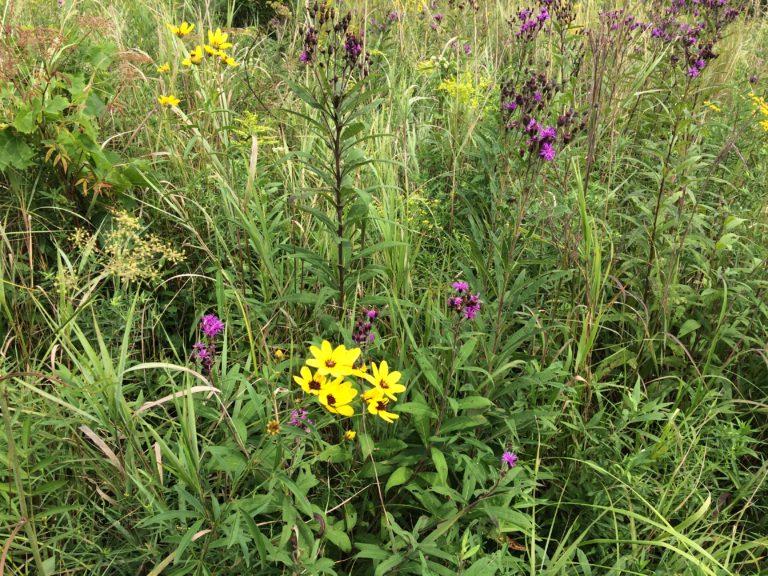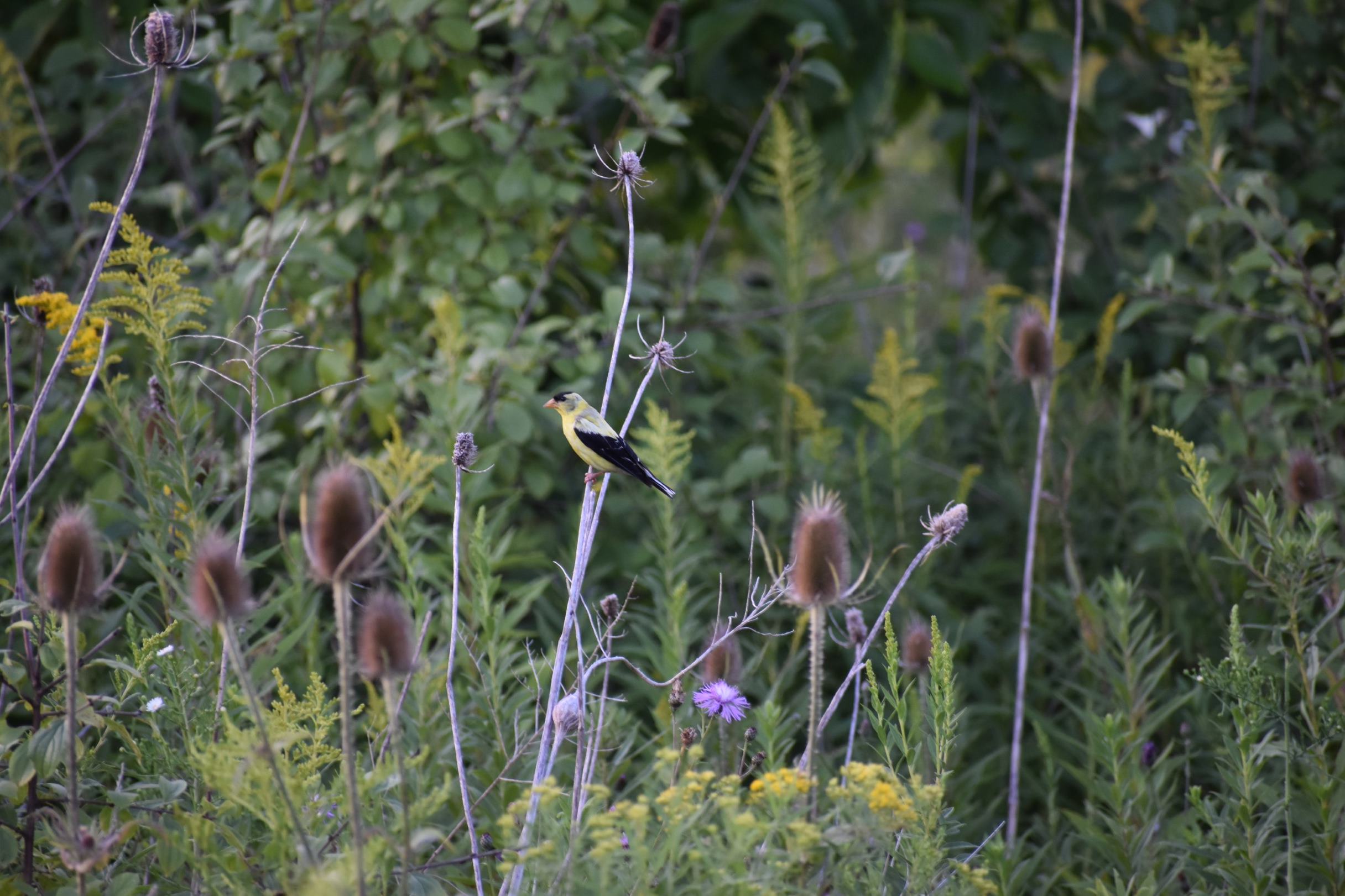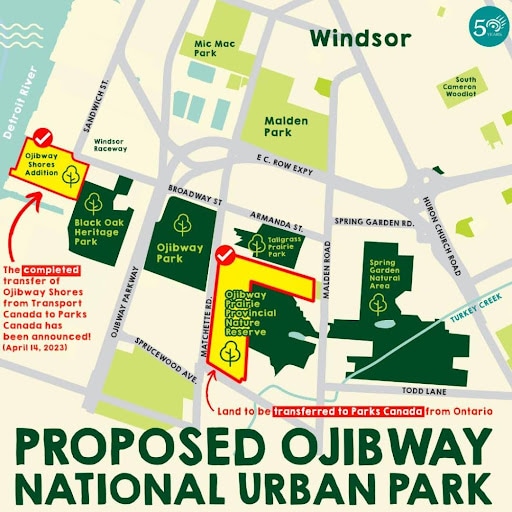Windsor, Ontario

Takeaways
Windsor has the mix for the next National Urban Park: strong advocates from indigenous and local people right up to all-party support in Parliament; legislation in the Senate along with a thorough establishment and engagement process by Parks Canada; a frightfully rare ecosystem with opportunities for connections to the wider landscape, and, a desperate need for climate stability. Canada needs a Nature Strategy for southern and urban areas. Let’s finish the job in Windsor and lead the way for more National Urban Parks across Canada.
“Windsor is home to Tallgrass Prairie, resilient to a warming climate and extreme weather. National Urban Park protection will open opportunities to restore, protect and connect the natural landscapes in and around Windsor.”
— Dave Pearce Senior Forest Conservation Manager, Wildlands League
“Governments have shown unanimous support for Ojibway National Urban Park. The Federal Government has secured Ojibway shores, Ontario and the city of Windsor have agreed to contribute the largest properties and Caldwell and Walpole Island First Nations both support the Park. Caldwell First Nation has signed a Memorandum of Understanding with Parks Canada working towards shared governance and collaborative management in the Park.”
— Janet Sumner Executive Director, Wildlands League
Ojibway, Canada's second National Urban Park to be
Windsor is home to Tallgrass Prairie, the most endangered ecosystem in Canada, containing more rare species than anywhere else in Ontario. Tallgrass is also the landcover most resilient to a warming climate and extreme weather and stores carbon deep in its soils. It is a natural sponge, combatting extreme drought and flooding, very important in Windsor, the ‘flood capital of Canada.’ This would be the second National Urban Park in Canada after Rouge and help Canada in its commitments to protect 30% of Canada, halt and reverse biodiversity loss while fighting climate change and establishing 6 new National Urban Parks by 2025.
Grassroot groups have been trying to establish a new National Urban Park for years to better conserve the tallgrass prairie and savannah and save Ojibway Shores, the last piece of undeveloped Detroit River shoreline in Windsor. Local initiatives (eg. Save Ojibway Shores campaign, petitions, public meetings, securing a coalition of community groups, environmental groups and unions) secured support of City Council, local environmental groups and First nations.
Parks Canada launched its National Urban Parks program in 2021 with Windsor as one of the priorities. Parks Canada has conducted pre-feasibility and early planning including engagement activities through 2023. Meanwhile, Brian Masse, MP for Windsor West, crafted a private members bill (C-248) that would amend the Canada National Parks Act with an addition of the Ojibway Prairie Complex lands. This Bill is now in the Senate having passed Third Reading in the House of Commons with all party support. Wildlands League has publicly supported C-248 as an effective way to establish the Park under strong legislation that will be a bulwark for ecological integrity. The Parks Canada establishment process will build support and a vision with the details to be incorporated in a management plan. Lands from the study area can be added to Bill C-248 by means of orders in council.
 Gold Finch
Gold Finch
Biodiversity and Ecosystem
The proposed site includes tallgrass prairie and savannah, wetlands, shorelines, and forests. It is the largest remnant of tallgrass in Ontario and the last undeveloped river shoreline in Windsor.
The private members bill identifies over 360 hectares for Park establishment. The study area is almost 900 hectares which could add lands to the Park.
This site has the highest concentration of rare species in Ontario. 100 rare plants, 252 birds, 10 at-risk reptiles; 2 at-risk mammals. Examples of species at risk include the eastern massasauga, eastern foxsnake, Butler’s gartersnake, pink milkwort, pale purple foxglove, white-tubed colicroot, dense blazing star, willow leaved aster, purple twayblade, prairie rose, and slender bushclover.
Ojibway National Urban Park’s alignment to the Global Biodiversity Framework
A National Urban Park in Windsor would support the following targets of the Global Biodiversity Framework:
- Target 1: Plan and Manage all Areas to Reduce Biodiversity Loss;
- Target 2: Restore 30% of all Degraded Ecosystems
- Target 3: Conserve 30% of Land, Waters and Seas
- Target 4: Halt Species Extinction, Protect Genetic Diversity, and Manage Human-Wildlife Conflicts
- Target 6: Reduce the Introduction of Invasive Alien Species by 50% and Minimize Their Impact
- Target 8: Minimize the Impacts of Climate Change on Biodiversity and Build Resilience
- Target 11: Restore, Maintain and Enhance Nature’s Contributions to People
- Target 12: Enhance Green Spaces and Urban Planning for Human Well-Being and Biodiversity
Ojibway National Urban Park’s alignment to the Sustainable Development Goals
A National Urban Park in Windsor would contribute to the UN’s Sustainable Development Goals, including:
- Goal 11: Make cities and human settlements inclusive, safe, resilient and sustainable.
- Goal 13: Take urgent action to combat climate change and its impacts
- Goal 14: Conserve and sustainably use the oceans, seas and marine resources for sustainable development
- Goal 15: Protect, restore and promote sustainable use of terrestrial ecosystems, sustainably manage forests, combat desertification, and halt and reverse land degradation and halt biodiversity loss.
Further reading
- Proposal updates
- We Need a Nature Strategy for Southern Canada – Could Windsor Be Part of It?
- Watch: The People's Summit (90 min)
- City of Windsor: National Urban Park
 Proposed Ojibway National Urban Park, from Wildlands League
Proposed Ojibway National Urban Park, from Wildlands League